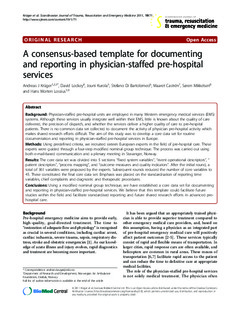| dc.contributor.author | Krüger, Andreas J. | |
| dc.contributor.author | Lockey, David | |
| dc.contributor.author | Kurola, Juoni | |
| dc.contributor.author | Di Bartolomeo, Stefano | |
| dc.contributor.author | Castrén, Maaret | |
| dc.contributor.author | Mikkelsen, Søren | |
| dc.contributor.author | Lossius, Hans Morten | |
| dc.date.accessioned | 2015-09-25T12:04:12Z | |
| dc.date.accessioned | 2015-10-07T12:42:32Z | |
| dc.date.available | 2015-09-25T12:04:12Z | |
| dc.date.available | 2015-10-07T12:42:32Z | |
| dc.date.issued | 2011 | |
| dc.identifier.citation | Scandinavian Journal of Trauma, Resuscitation and Emergency Medicine 2011, 19:14 | nb_NO |
| dc.identifier.issn | 1757-7241 | |
| dc.identifier.uri | http://hdl.handle.net/11250/2353182 | |
| dc.description.abstract | Background: Physician-staffed pre-hospital units are employed in many Western emergency medical services (EMS)
systems. Although these services usually integrate well within their EMS, little is known about the quality of care
delivered, the precision of dispatch, and whether the services deliver a higher quality of care to pre-hospital
patients. There is no common data set collected to document the activity of physician pre-hospital activity which
makes shared research efforts difficult. The aim of this study was to develop a core data set for routine
documentation and reporting in physician-staffed pre-hospital services in Europe.
Methods: Using predefined criteria, we recruited sixteen European experts in the field of pre-hospital care. These
experts were guided through a four-step modified nominal group technique. The process was carried out using
both e-mail-based communication and a plenary meeting in Stavanger, Norway.
Results: The core data set was divided into 5 sections: “fixed system variables”, “event operational descriptors”, “
patient descriptors”, “process mapping”, and “outcome measures and quality indicators”. After the initial round, a
total of 361 variables were proposed by the experts. Subsequent rounds reduced the number of core variables to
45. These constituted the final core data set. Emphasis was placed on the standardisation of reporting time
variables, chief complaints and diagnostic and therapeutic procedures.
Conclusions: Using a modified nominal group technique, we have established a core data set for documenting
and reporting in physician-staffed pre-hospital services. We believe that this template could facilitate future
studies within the field and facilitate standardised reporting and future shared research efforts in advanced prehospital
care. | nb_NO |
| dc.language.iso | eng | nb_NO |
| dc.publisher | BioMed Central | nb_NO |
| dc.title | A consensus-based template for documenting and reporting in physician-staffed pre-hospital services | nb_NO |
| dc.type | Journal article | nb_NO |
| dc.type | Peer reviewed | en_GB |
| dc.date.updated | 2015-09-25T12:04:12Z | |
| dc.source.volume | 19 | nb_NO |
| dc.source.journal | Scandinavian Journal of Trauma, Resuscitation and Emergency Medicine | nb_NO |
| dc.identifier.doi | 10.1186/1757-7241-19-71 | |
| dc.identifier.cristin | 924076 | |
| dc.description.localcode | © 2011 Krüger et al; licensee BioMed Central Ltd. This is an Open Access article distributed under the terms of the Creative Commons Attribution License (http://creativecommons.org/licenses/by/2.0), which permits unrestricted use, distribution, and reproduction in any medium, provided the original work is properly cited. | nb_NO |
